 |
| Spring Frost by Elioth Gruner |
According to visitor feedback, this is the ‘most-loved Australian landscape painting’ in the gallery. Elioth Gruner painted it in 1919 en plein air at Emu Plains. The cattle breath and morning shadows reaching out to the viewer, hark back to a rural nostalgia which was rapidly disappearing. The vigorous foreground brushwork and the sense of light and tone create a wistful world worth fighting for.
I also like his later work, which is more severe in form and outline. By emphasising the subtle harmonies of tone and colour, he creates a feeling of stability and permanence in contrast to his former exploratons into the evanescence of light. These organised pictures are more scientific and less emotional, but the landscape is familiar to me, with the sweep of hills to the valley river corridor, being the view from the back of our house.
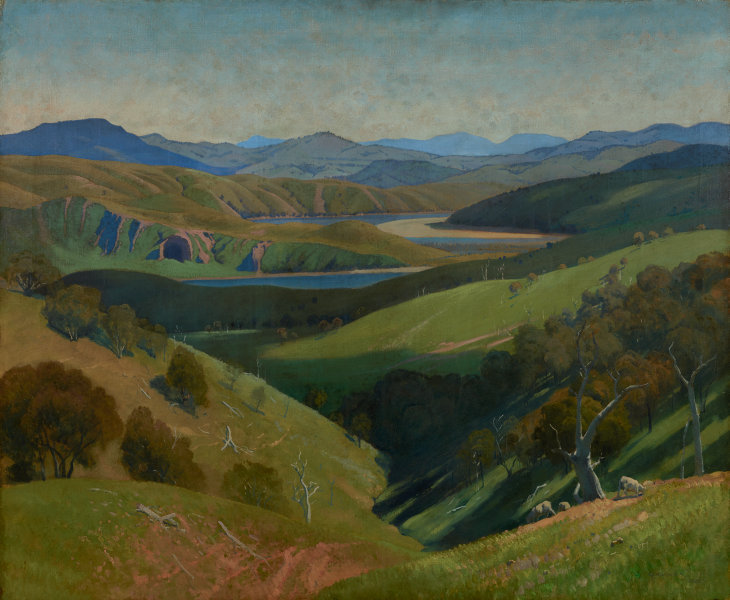 |
| On the Murrumbidgee (1929) - Elioth Gruner |
I love Nora Heysen's work from her still lifes to her war paintings and her self-portraits. Nora Heysen’s self-portrait strongly articulates her identity and ambition as a young artist, independent of her famous artist-father Hans Heysen. Characteristic of her 1930s’ paintings, Self portrait is powerfully composed with precise, strongly defined forms and earthy colours recalling European masters of the early Renaissance. After undertaking study in Europe, Heysen established herself as a distinguished portrait and still-life painter. In 1938 she won the Archibald Prize, the first woman to have done so." - from the Art Gallery of New South Wales' website.
This particular portrait was painted in her father's studio (which we have visited), with the Vermeer prints on the walls. Nora wrote, "I greatly admired Vermeer’s works and wanted to paint like him – perhaps Vermeer and my father were my biggest influences in those days …"
 |
| Self Portrait (1932) - Nora Heysen |
Margaret Preston is another favourite, and the development of her art and style is quite fascinating. Her still lifes are spectacular, including Summer and Still life with daisies and teapot, both painted in 1915. On 25 April 1915 Australian and New Zealand Army Corps landed on the Gallipoli Peninsula in Turkey, an action that came to signify Australia's emrging nationalism. At the time Preston (nee McPherson) was in England, whence she had moved from Paris after the outbreak of war. Despite the horror and trauma she encountered - she taught pottery and basket-weaving to shell-shocked soldiers - she continued to paint pleasant and cheerful still lifes.
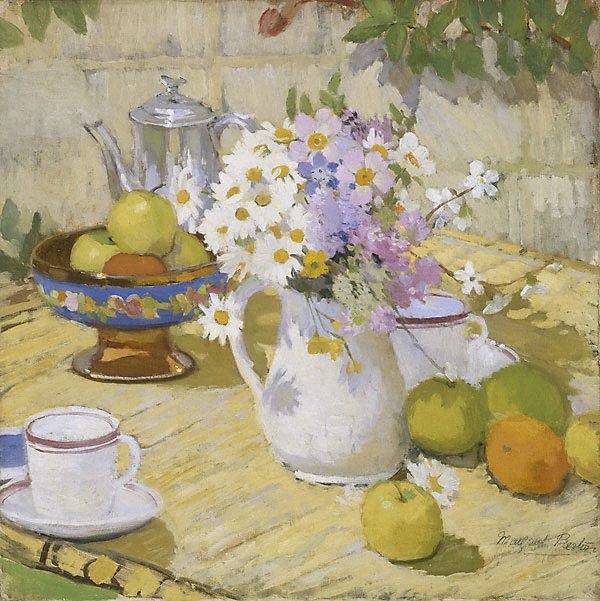 |
| Summer (1915) - Margaret Preston |
In Still life wth teapot and daisies, the flat white sands of Bunmahon places the table firmly outside as its pink striped cloth manipulates the viewer's eye around and back to the central construction of bowls, flowers and teacups so diminishing an artificial perspective that would be created if the stripes travelled into depth.
"Her engaging play with reflections, a device she returned to throguhout her long painting career, shows another landscape mirrored in the teapot. A hammock of pink cradles a solitary figure in a long dress holding a parasol ad standing in a green field with a blue sky, so introducing a human element to the painting's design. The figure could be the viewer or a partaker returning to the afternoon tea."
 |
| Still life with daisies and teapot (1915) - Margaret Preston |
The difference between Flowers and Australian gum blossom shows the dvelopment and future direction of Preston's work. Although she still painted flowers, she chose to embrace local flora and a less formal approach with confidence.
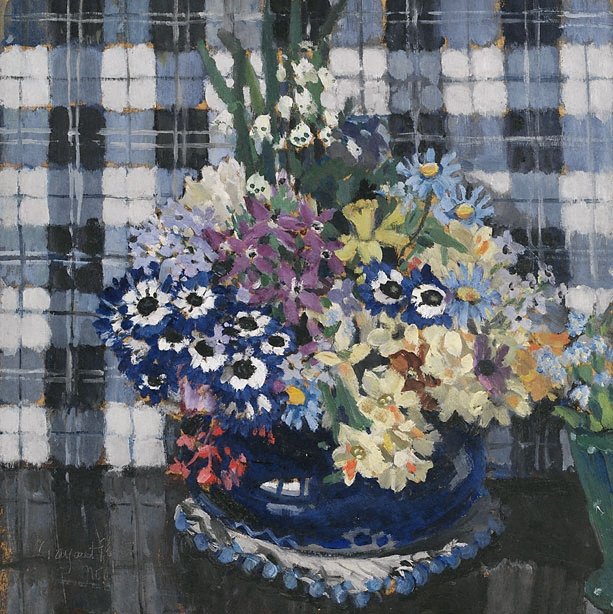 |
| Flowers (1922) - Margaret Preston |
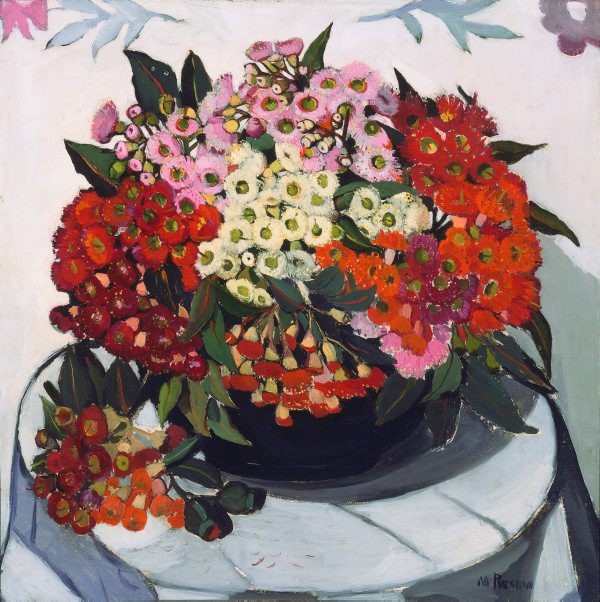 |
| Australian gum blossom (1928) - Margaret Preston |
In between, she also ventured into stylised groupings, such as in Thea Proctor's Tea Party. This painting belongs to the genre of still life, but it is also a kind of portrait. It is a symbolic rendering of the things that Thea Proctor stood for. Preston encapsulates her fellow artist's belief in the importance of surrounding one's self with objects of taste and beauty, and alludes to her enthusiasm for arranged flowers in domestic settings, something the two artists shared.
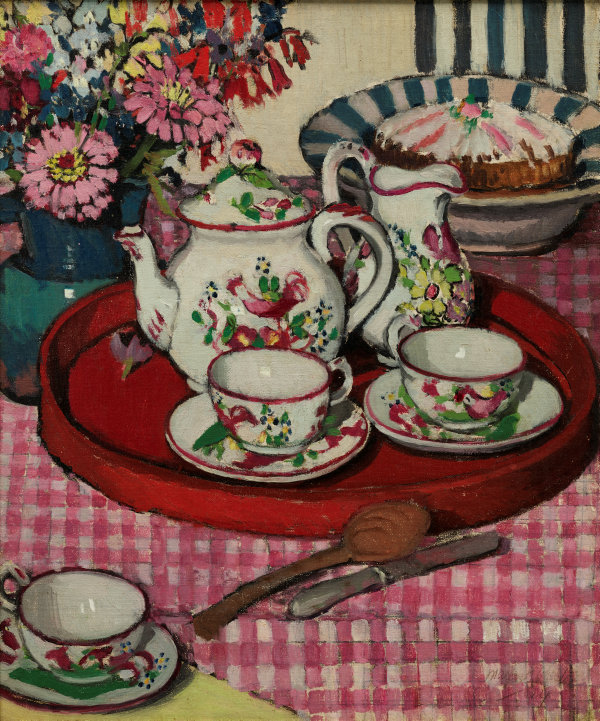 |
| The Proctor's tea party (1924) - Margaret Preston |
Meanwhile, Implement blue is one of Margaret Preston’s most innovative works, embodying the values of progressive, modern living. She felt that this was a mechanical age – highly civilised and unaesthetic. Impersonal inventions were introduced to make home-life easier, but she felt detached from domesticity.
The restricted palette and strict analysis of form in this painting reveal how she turns to the genre of still life to express her conceptual conflict. The domestic vessels have been renamed 'implements' and reduced to essential forms.
 |
| Implement Blue (1927) - Margaret Preston |
One of her most famous works is her 1930 Self Portrait, painted as a commission at the request of the Trustees of the Art Gallery of New South Wales. She later said, 'my self-porrait is completed, but I am a flower painter - I am not a flower." And yet, she has painted this image with the same attention to detail she brought to her still-lifes, incorporating the essentials of her art: her brush and palette and a pot of wildflowers.
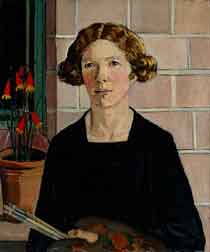 |
| Self Portrait (1930) - Margaret Preston |
Grace Cossington Smith’s The sock knitter has been acclaimed as the first post-impressionist painting to be exhibited in Australia. The extreme flattening of the picture plane and the use of bright, expressive, broken colour applied in broad brush-strokes to delineate form reflects the aesthetic concerns of European painters such as Cézanne, Matisse and van Gogh.
The subject of the painting is Madge, the artist’s sister, knitting socks for soldiers serving on the frontline in World War I. Distinctly modern in its outlook, The sock knitter counterpoints the usual narratives of masculine heroism in wartime by focusing instead on the quiet steady efforts of the woman at home.
 |
| The sock knitter (1915) - Grace Cossington-Smith |
In 1920 Cossington Smith was in the city when she noticed a crowd gathering. As she recalled: ‘I didn’t expect him to be there. I was in Martin Place and wondering why all the people were gathering, and someone said, “The Prince of Wales is going to drive by”. I was very excited and stood on the pavement and got an impression of it … then I think I made drawings of the buildings – a drawing rather – just to get it right. But I couldn’t while he was going by because it was only a few seconds, so I had to impress it on my mind’.
 |
| The Prince (1920) - Grace Cossington-Smith |
I also love the painting of Reinforcements, troops marching for the use of the lines and colour which create an upright sense of movement - you can almost hear the boots hitting the ground in unison. The women in their hats waving handkerchiefs to the men and turning their backs on the brawling brat on the ground also speaks volumes to me. There are moments when individual wants are less important than communal needs.
|
Reinforcements, troops marching (1917) - Grace Cossington-Smith
Inspired by the art deco designs and vivid colours of the David Jones department store cafe in Sydney, The Lacquer Room embodies the modern inter-war urban experience. The rich red and scattered patterns of the chairs are contrasted with the gleaming green of the lacquered tables, set against the brightness of the walls and polished floors. Grace Cossington Smith’s bold approach to colour exudes a sense of celebrating the new, similar to the contemporary consumer culture epitomised by the department store.
In an interview, she said, "It was quite a surprise, I didn't know it was there, but I went down to get cup of tea … and found this lovely restaurant … I was struck by its colour and general design the moment I saw it … Scarlet, green and white held me spellbound..."
 |
| The Lacquer Room (1935-36) - Grace Cossington-Smith |
Ethel Carrick painted vivacious impressionist-influenced European landscapes, market scenes and flower pieces. After studying in London early in the 20th century, Carrick settled in Paris in 1905 where she became actively involved with women’s painting societies. She travelled extensively with her artist-husband, E Phillips Fox, in France, Italy, Northern Africa and Spain.After Fox’s death in 1915, Carrick lived mostly abroad, travelling in Europe, painting in Majorca, Egypt, Morocco, Tunisia and India, and in the 1930s living in Kashmir. Her paintings commonly displayed an interest in figures, objects and her surrounding environment, rendered as patterns of colour and light.
 |
| Flower Market, Nice (1926) - Ethel Carrick |















No comments:
Post a Comment